Equipment
More PhotoGeekery: Finite Conjugate MTF Bench Tests for Macro Lenses

For the last several years we’ve talked about the fact that lens performance can vary with focusing distance. Our optical bench tests at infinity. Computerized target analysis (Imatest and DxO) tests at close distances. But when the results of target analysis and bench tests differ it’s hard to decide if the difference is because of different testing methods or because lenses actually do perform differently close-up and at a distance.
When I did target analysis testing, I was most uncomfortable about wide-angle lenses. They are being tested at distances under 6 feet and that’s not the distance they’re often used at. With bench testing, I have the opposite discomfort. We were testing macro lenses at infinity, but they are most likely going to be used close up. In both cases, I wondered how much testing distance affected performance.
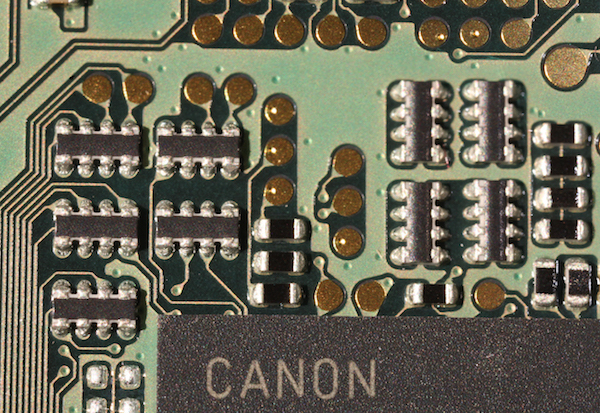
Random macro image because social media consultants say we should have more pictures since reading is hard.
Faced with this dilemma, I did what I usually do; I spent more money and bought a finite conjugate modification for our optical bench. This allows us to test lenses at close focusing distance with the same methods we use to test at infinite focusing distance. So now we can use the same testing method to see how much difference focusing distance makes.
The finite conjugate is rather difficult to use, time consuming to test with, and it has some limitations. The most important of these restrictions is it only works at really close focusing distances; 3 feet or less. But that’s perfect for macro lens testing.
Remember, please, that we’re letting you look over our shoulder in nearly real-time. This whole piece of equipment is a new addition to our lab. Diego has spent most of the summer working the kinks out, and I’m very comfortable with the results we’re getting — right now. But a few thousand lens tests from now I may realize we should be doing something differently.
Some Lens Background Information
The vast majority of photography lenses are designed for best performance at infinity. When lenses are focusing close, we expect performance to deteriorate to some degree. Most photographers are aware of this and expect a lens to be softer near the minimum focusing distance. Field curvature can also change with focusing distance.
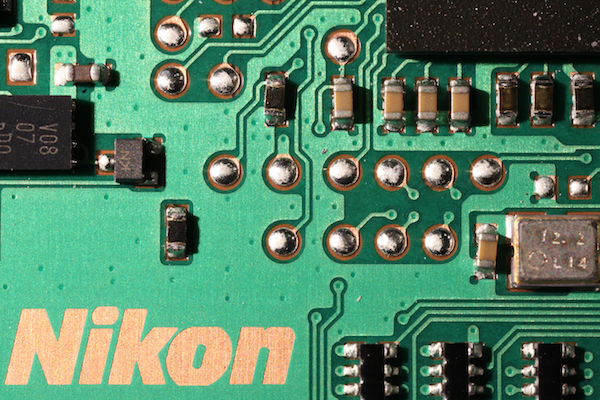
Another one like the other one, but different brand to minimize Fanboy uproar.
Macro lenses, at least the better macro lenses, must keep good performance when focusing closely, so they should be as good, or even better at close distances than far away. They should also have a very flat field at close focusing distances.
Comparison of Macro Lenses at Infinity and at 1:2 magnification
We’ve tested five macro lenses both at infinity and at 1:2 magnification focusing distance. For all lenses, the infinity MTF is on the left, the 1:2 macro distance MTF is on the right. (For each lens, we tested 5 copies and averaged the results to obtain the MTF charts you’ll see below.) And, of course, you can click on the image to see it in more detail.
Canon 100mm f/2.8 IS L
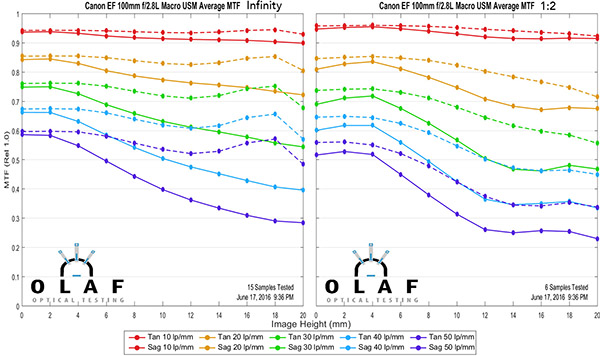
OlafOpticalTesting.com
The Canon 100mm f/2.8 L lens is a little better for low frequencies (red lines) at close distances than it is at infinity. Otherwise, it doesn’t change a lot.
Zeiss 100mm f/2 Macro Planar
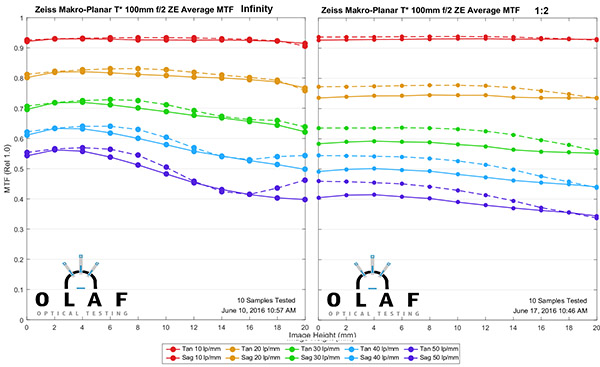
OlafOpticalTesting.com
The Zeiss stays the same at low frequencies, or maybe a hair better, while it falls off a bit at higher frequencies. But the flatness of the curves from center to edge, especially considering this lens is being tested at f/2, is just amazing.
Sony FE 90mm f/2.8 Macro
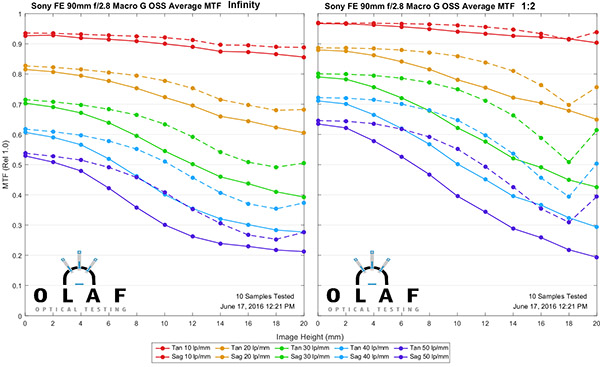
OlafOpticalTesting, 2016
The Sony FE 90mm f/2.8 Macro totally shocked me. It’s clearly better at all frequencies at macro distances. In fact, it’s the highest resolving off all these lenses at macro distances, at least in the image center. I’m not certain if it’s related or just coincidence, but the Sony lens has electronic motors controlling both the focusing and the compensating element. As best I know, all of the other macro lenses tested have mechanical movements of the compensating elements.
(Note: as with all Sony FE bench tests we do, the 20mm results are probably inaccurate because we have far fewer measurements at 20mm because of the light baffle.)
Zeiss 50mm f/2 Makro-Planar
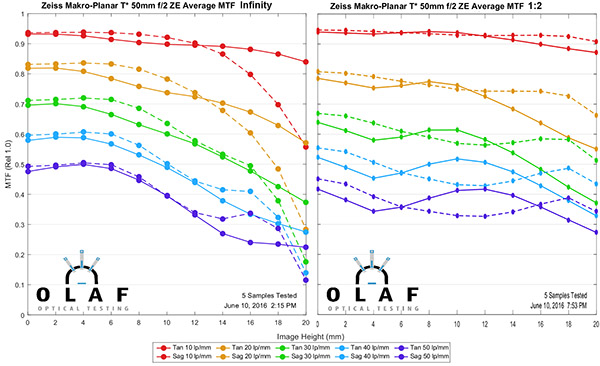
OlafOpticalTesting, 2016
The Zeiss 50mm f/2 Makro-Planar behaves much like the 100mm. It’s better off-axis at macro distances, and about the same on axis.
Sigma 150mm f/2.8 APO Macro
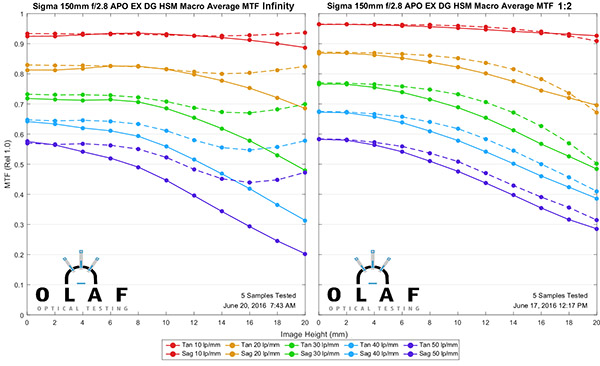
OlafOpticalTesting.com
The Sigma 150mm f/2.8 APO Macro also is better at close distances than it was at infinity, but it’s very good at both distances. It has a bit less astigmatism at closer distances.
Overall I was a bit surprised that some of the macro lenses were better at macro distances than at infinity. That’s what we would hope, of course, but I’m surprised that it happened. My expectation was that they might be as good, but not that they would be better.
Micro-Nikkor 105mm f/2.8 G VR
We didn’t have this one done in time to make the original article, but I know there is interest so I’ve added this. This graph was done after the others with a new widget Marcus programmed, that I think makes comparison easier. The Macro 1:2 distance is on the left, infinity on the right. Again, you can see performance is better at macro distances, particularly in the center.
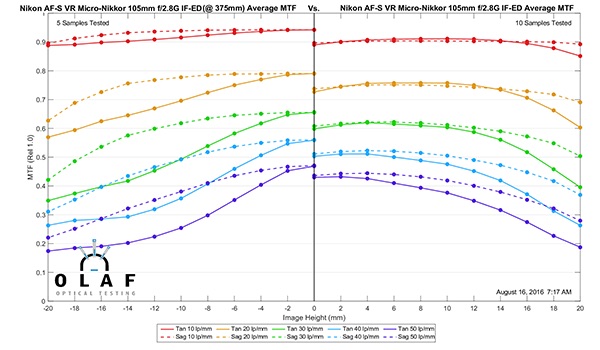
Olaf Optical Testing, 2016
Field Curvatures
We don’t average field curvature images from multiple lenses like we do with MTF data, there are just too many data points. These field curvatures are taken from a single copy, but we selected these from the batch we MTF tested, choosing average copies to show you.
Now we’re going to look behind the curtain a bit, so if you haven’t the stomach to look at actual single-lens images you might get queasy here. I see this all day, every day, but don’t write about it much because I’m afraid it will cause mass hysteria. But the reality is when we look at many copies of a lens, some of them are going to show field tilt, usually in the tangential plane. It’s a variation; just like MTF and aberrations vary a bit copy-to-copy so do field tilts.
A couple of the examples I’m going to show, do just that. DO NOT go online and look like a fool saying “Well, this lens has field tilt in Roger’s blog post.” Because then I’ll show you a couple of dozen examples of your favorite lens with more field tilt. No brand is without it, and trust me, none of these tilts are bad at all. It’s one of those unpleasant secrets like ‘there is no Santa Claus’ that we just have to learn to cope with.
For each lens, I’m going to show you a group of 4 field measurements: sagittal on the left, tangential on the right, infinity focus above and macro distance below.
Canon 100mm f/2.8 IS L
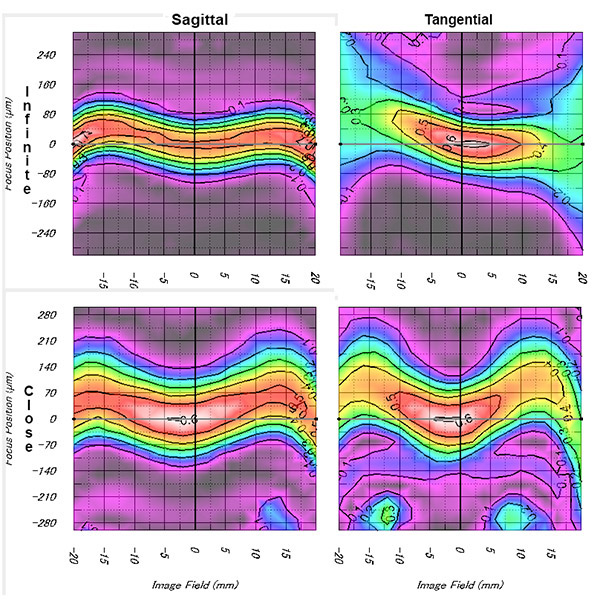
OlafOpticalTesting, 2016
If you look closely, you should notice two things. First, at infinity, there is a bit of tilt to the tangential field that goes away close up. This is specific to this copy; one of the cams that move an element isn’t perfectly parallel to the axis of the lens, so there’s a bit of tilt at one end. This is pretty common. Every zoom has a bit of it, and some primes do too.
Second, if you ignore the tilt and look at the tangential field shape, you’ll see that the sagittal and tangential fields match up better at close distances. This probably has something to do with the change of ‘astigmatism-like’ separation on the MTF curves above. (I use the term astigmatism-like because lateral color and some other things affect that MTF pattern.)
Zeiss 100mm f/2 Makro-Planar
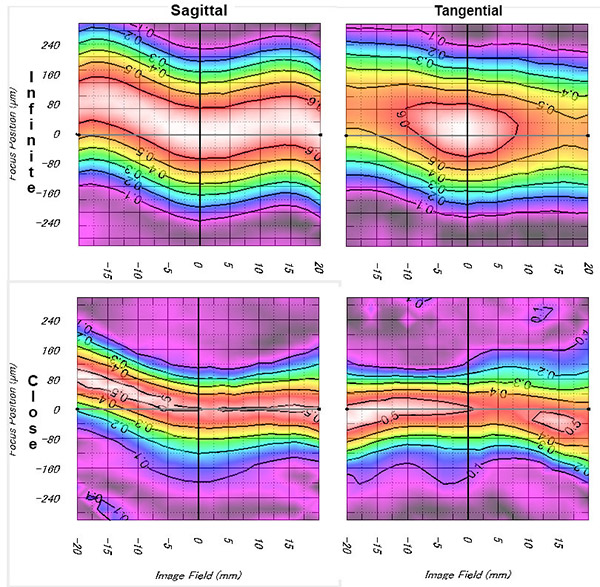
OlafOpticalTesting, 2016
In this copy there is a bit of field tilt that doesn’t change much with focusing distance, so it probably doesn’t involve a focusing element. The field curvature changes shape a bit as we go from infinity to macro distances, but if anything it’s a bit it’s pretty flat at either end, much like the MTF curves were.
Sony FE 90mm f/2.8 Macro
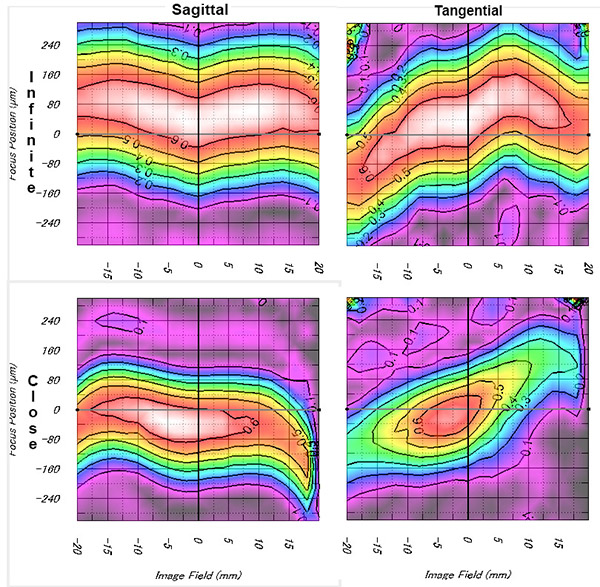
OlafOpticalTesting, 2016
Here we have another example of tilt in the tangential field that isn’t changing with focusing distance. If you mentally rotate that tangential infinity curve, though, you may visualize that while both sagittal and tangential fields change shape at closer distances, they do it in the same way.
Zeiss 50mm f/2 Makro-Planar
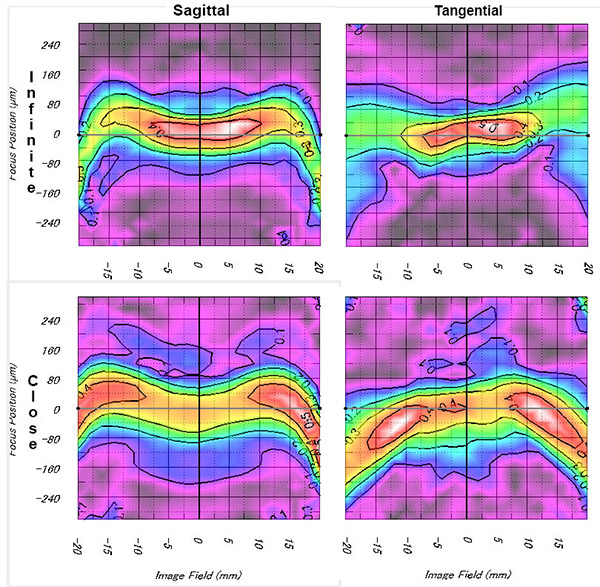
OlafOpticalTesting, 2016
It’s an interesting exercise to compare the change in field curvature with this lens to the change in astigmatism-like pattern in its MTF charts. While the field doesn’t flatten at close distances, the sagittal and tangential fields do become more similar.
Sigma 150mm f/2.8 APO Macro
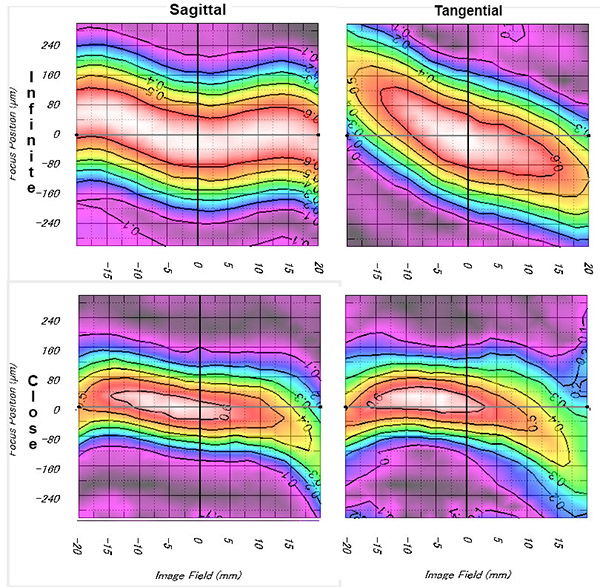
OlafOpticalTesting, 2016
This lens gives us another example of a field tilt that only shows up at one end of the focusing range, and also of field curvature that changes the pattern a little bit and matches up better at the macro than at the longer end. Look back at the MTF charts to see how that affects astigmatism with this lens.
So What Did We Learn Today?
Well, first and foremost I think we confirmed that I’m overly cynical. The macro lenses we tested were all at least as good at macro distances, and in some cases better than they were at infinity focus. Like they are supposed to be. And like I thought they wouldn’t be.
We also confirmed that the shape of field curvature does change a bit at different focusing distances. And I learned that lens designers apparently take this into account to flatten the field at macro shooting distances. (Yay lens designers!!!)
Some of you probably learned that lenses vary more than you thought they did, at least when you test with lab equipment. You’ll have to take my word for it, but these are all really minor field tilts that you would not notice in a photograph. If you were pixel peeping with careful test chart or brick wall pictures, you might be able to detect the tilt if you had several copies to compare, and a lot of free time.
We’ll probably show you some more impressive tilts with zoom lenses one of these days. I guarantee most of you will get nauseous when you see how your ‘good as a prime’ zoom lens does with field tilts.
Roger Cicala, Aaron Closz, and Diego Martinez
Lensrentals.com
June, 2016.
Author: Roger Cicala
I’m Roger and I am the founder of Lensrentals.com. Hailed as one of the optic nerds here, I enjoy shooting collimated light through 30X microscope objectives in my spare time. When I do take real pictures I like using something different: a Medium format, or Pentax K1, or a Sony RX1R.
-
Roger Cicala
-
Ralph Hightower
-
Robert York
-
Philip
-
Philip
-
Roger Cicala
-
obican
-
Eric D
-
Kers
-
JJ
-
Roger Cicala
-
Philip
-
Bill
-
Hakann Vatansever
-
King
-
Freddo
-
Roger Cicala
-
yaley
-
Maya
-
Roger Cicala
-
Maya
-
l_d_allan
-
Roger Cicala
-
Roger Cicala
-
Claudia Muster
-
Brandon Dube
-
Taki
-
speedy fisher
-
Chris Jankowski
-
Mike Aubrey
